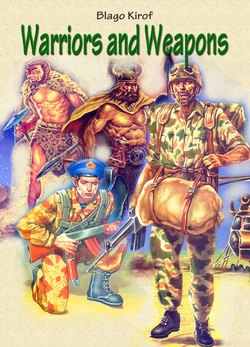Читать книгу Warriors and Weapons - Blago Kirof - Страница 2
На сайте Литреса книга снята с продажи.
War and Warriors
ОглавлениеOne legend has it that the Romans adopted a Germanic word for "war", to avoid using the Latin "bellum", because, when sounded, it tended to merge with the sound of the word "bello" - beautiful. War is an organised conflict that is carried out by states or non-state actors. It is personified by extreme violence, disruption, and destruction. War should be understood as an extensive armed conflict between taking sides communities, and consequently is defined as a form of violence or intervention. The set of techniques used by a group to carry out war is known as warfare.
Before the dawn of civilization, war likely consisted of small-scale raiding. One half of the people found in a Nubian cemetery dating to as early as 12,000 years ago had died of violence. Since the rise of the state some 5,000 years ago, military activity has occurred over much of the globe. The advent of gunpowder and the acceleration of technological advances led to modern warfare. According to one source, 14,500 wars have taken place between 3500 BC and the late 20th century, costing 3.5 billion human lives, leaving only 300 years of peace. Approximately 95% of known societies throughout history engaged in at least occasional warfare, and many fought constantly. It is problematic however to suggest that people in past societies are any more violent than people today. In Western Europe, only since the late 18th century, more than 150 conflicts and about 600 battles have taken place.
At the end of each of the last two World Wars, concerted and popular efforts were made to come to a greater understanding of the underlying dynamics of war and to thereby hopefully reduce or even eliminate it all together. Shortly after World War II, as a token of support for this concept, most nations joined the United Nations. In 1947, in view of the rapidly increasingly destructive consequences of modern warfare, and with a particular concern for the consequences and costs of the newly developed atom bomb, Albert Einstein famously stated, "I know not with what weapons World War III will be fought, but World War IV will be fought with sticks and stones."
So - the circle closes - humankind began its first war with sticks and stones and faces the danger of fought its last war again with sticks and stones. It is logical to assume that if there is war, there are warriors. A warrior is individual skilled in combat or warfare, especially within the context of a tribal or clan-based society that recognizes a separate warrior class.
In tribal societies warriors often form a caste of their own. In feudalism, the vassals essentially form a military or warrior class, even if in actual warfare, peasants may be called to fight as well. In some societies, warfare may be so central that the large parts of the male population may be considered warriors, for example in the Iron Age Germanic tribes and Indian clans like the Sikhs.
While the warrior class in tribal societies is typically all-male, there are some exceptions where women formed part of the warrior class. A supposed group of fighting women is the legendary Amazons, recorded in Classical Greek mythology.
The military caste in a feudal society is evolved from the warrior class in a tribal society. This includes the Khalsa and Kshatriya castes in ancient India, the samurai class in feudal Japan, and noble knights in feudal Europe.
With the end of the Middle Ages and the professional standing armies of Early Modern warfare, the concept of a "warrior class" or "military caste" became an relic. The term "warrior" is still sometimes used to refer to professional soldiers or mercenaries. In addition to the literal meaning, now mostly historical, the term has acquired a figurative sense referring to a person who shows or has shown great vigor or courage.
